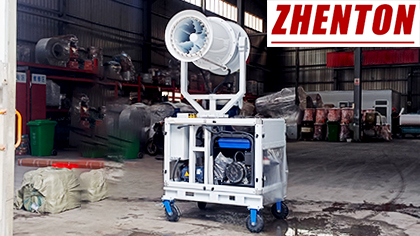Dust Control is a Critical Aspect of Maintaining a Safe and Efficient Industrial Environment.Industrial Fog Cannons Have Emerged as a Highly Effective Solution for Dust Suppression,Leveraging Advanced Technology to Mitigate Airborne Dust Particles.This Article Explores the Intricate Details of Dust Suppression Systems,Focusing on the Application of Calcium Chloride,the Types of Dust Control Systems,and Alternative Methods for Effective Dust Management.
The Role of Calcium Chloride in Dust Suppression
Calcium Chloride is a Widely Used Compound in Dust Suppression Due to Its Hygroscopic Properties,Meaning It Can Absorb Moisture from the Air.This Characteristic Makes It an Excellent Agent for Controlling Dust,Particularly on Road Surfaces and Industrial Sites.
Mixing Calcium Chloride with Water
To Prepare a Practical Solution,a Concentration Between 10 and 30 Percent is Recommended.For Instance,Adding Approximately 120 Grams of Near-Anhydrous Solid Calcium Chloride Per Liter of Water Yields a 10 Percent Solution.In U.S.Units,This is Roughly Equivalent to 1 Pound Per Gallon.For Optimal Dust Control on Road Surfaces,a 38 Percent Solution of Liquid Calcium Chloride Should Be Applied at a Rate of 0.27 Gallons Per Square Yard.This Concentration Has Proven to Be Ideal for Binding Dust Particles and Reducing Airborne Dust.

Alternative Dust Suppression Agents
While Calcium Chloride is Effective,There Are Substitutes Such as Alum and Rock Salt.Alum is Commonly Used in the Pickling Process to Keep Cucumbers Crisp but Can Also Serve as a Dust Control Agent.Rock Salt,Another Alternative,Can Be Used in Place of Calcium Chloride Under Certain Conditions.
Dust Suppression Methods
Dust Suppression Systems Can Be Broadly Categorized into Two Types:Low-Pressure and High-Pressure Systems.
Low-Pressure Systems
Low-Pressure Systems Are Designed for Preliminary Dust Prevention.These Systems Typically Operate by Spraying a Mixture of Water and Dust Control Agents,Such as Calcium Chloride,onto the Surface.The Water Helps to Bind the Dust Particles,Preventing Them from Becoming Airborne.
High-Pressure Systems
High-Pressure Dust Suppression Systems,Also Known as Misting Systems,Are More Advanced.These Systems Create an Ultra-Fine Fog that Captures Dust Particles in the Air,Causing Them to Settle Without Leaving a Wet Residue.This Method is Particularly Effective in Environments Where Excessive Moisture Could Be Problematic.
Dry Dust Suppression Methods
In Addition to Wet Suppression Methods,Dry Suppression Systems Are Also Available.These Systems Utilize Ultra-Fine Fog to Create a Barrier that Dust Particles Cannot Penetrate.This Method Functions Similarly to a Fabric Filter,Trapping Dust Particles and Preventing Them from Dispersing into the Air.
Removing Calcium from Water
In Some Industrial Applications,It is Necessary to Remove Calcium from Water.Common Methods for Calcium Removal Include Reverse Osmosis,Chemical Treatment,Water Softening,and Distillation.These Processes Help to Maintain Water Quality and Prevent Scaling in Equipment.
Spray Solutions for Dust Suppression
ZhenTon is an Effective and Economical Solution for Dust Suppression.This Product Locks in Dust While Allowing Air and Water to Penetrate the Surface,Making It Suitable for a Wide Range of Soil and Sand Types.ZhenTon is Particularly Useful When Dust Control is Needed Immediately,but Long-Term Revegetation is Also a Goal.
Properties of Calcium Chloride
When Calcium Chloride Gets Wet,It Undergoes a Deliquescent Process,Absorbing Enough Moisture to Convert into Liquid Brine.This Reaction is Exothermic,Releasing Heat as It Dissolves in Water. These Properties Make Calcium Chloride an Effective Agent for Dust Control,as It Continuously Attracts Moisture from the Environment.
Desiccants in Dust Suppression
Desiccants Such as Bentonite Clay and Silica Gel Are Also Used in Dust Suppression.These Substances Are Highly Hygroscopic,Meaning They Can Absorb and Retain Moisture.This Makes Them Ideal for Protecting Products from Degradation Due to Moisture,Ensuring Product Quality and Longevity.










